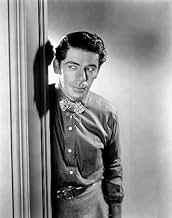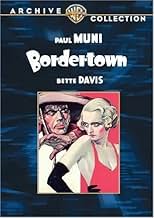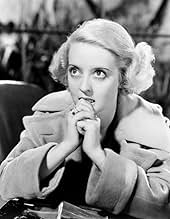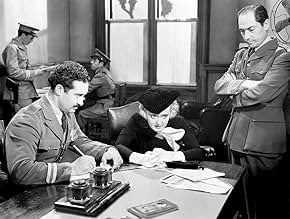IMDb रेटिंग
6.6/10
2.1 हज़ार
आपकी रेटिंग
अपनी भाषा में प्लॉट जोड़ेंIn Mexico, a former lawyer becomes the invaluable second-in-command to a casino owner, whose wife begins to fall for him.In Mexico, a former lawyer becomes the invaluable second-in-command to a casino owner, whose wife begins to fall for him.In Mexico, a former lawyer becomes the invaluable second-in-command to a casino owner, whose wife begins to fall for him.
Soledad Jiménez
- Mrs. Ramirez
- (as Soledad Jimenez)
William B. Davidson
- Dr. Carter
- (as William Davidson)
Oscar Apfel
- Judge Rufus Barnswell
- (बिना क्रेडिट के)
Wade Boteler
- Man Wanting to Buy Roark's Casino
- (बिना क्रेडिट के)
Glen Cavender
- Man Restraining Johnny in Courtroom Fight
- (बिना क्रेडिट के)
Jack Chefe
- Waiter
- (बिना क्रेडिट के)
Wallis Clark
- Friend of Dean on Podium
- (बिना क्रेडिट के)
Carlos De Valdez
- Magistrado
- (बिना क्रेडिट के)
कहानी
क्या आपको पता है
- ट्रिवियाAt first, Paul Muni wanted Carole Lombard or Lupe Velez as female co-star, but after her success in Of Human Bondage (1934) he chose Bette Davis.
- गूफ़When Johnny Ramirez shortly after losing the case leaves his home and starts hitchhiking, you see a montage of calendar months indicating the passage of time. But the dates of the month do not correspond with the year 1934, which was the year of the trial as indicated by the court papers filed. Also, the sequence of calendar dates shown in the montage is out of order. They begin with August of 1936 and end with July 1936 as opposed to July 1937.
- भाव
Marie Roark: The only fun I get is feeding the goldfish, and they only eat once a day.
- कनेक्शनFeatured in Code of the Secret Service (1939)
- साउंडट्रैकMaria Elena
(1933) (uncredited)
Music by Lorenzo Barcelata
Played at the beginning and often in the score
फीचर्ड रिव्यू
As a poor Mexican-American boy, Muni labors to get a night-school law degree, but can't make a professional living in such a poor neighborhood. Ambitious and tough, he works his way into heading a gambling casino. Though a financial success, he loses his way in a white- dominated social world.
It's 1934 and the notorious Hollywood Production Code has just kicked in. Few studios were more affected than Warner Bros., the home of the uncompromising gangster films of Cagney, Robinson, and Muni. There are elements of the typical rags-to-riches gangster theme in this movie, but the tone and content have altered from the pre-Code product. Note the complete absence of gunplay, dead bodies, brutality, and other staples of such pre-Code classics as Public Enemy (1931), Little Caesar (1931), and Scarface (1932).
Technically, this is not a gangster movie-- Muni may be shady, yet he's no criminal. But that too, I believe, results from trying to get right with the new Code. Note how business rivals try to buy out Palette's casino instead of just muscling-in in classic gangster fashion. And though the girls sport some pretty revealing gowns, Muni refuses Davis's overtures, while remaining unclear on his relationship with Lindsey. Such compromises likely result from the producers not wanting sexual relationships to cross racial lines. Contrast this with the strong hints of incest, no less, in the free-wheeling Scarface.
In short, the movie has the trappings of a gangster film, yet departs in ways that I think are traceable to the newly installed Code. Among others, the new strictures were supposed to end public enthrallment with the underworld by deglamorizing it. Thus, Bordertown lacks many of the risky elements that made Warner Bros. such a riveting and dynamic studio during its classical period.
Now, this is not to say the movie is without interest or entertainment value. It took some guts to make Muni's central character a Mexican-American and cast him in a sympathetic light. In fact, the only thoroughly dislikable character is Lindsey's snobbish white boyfriend (Manville). At the same time, I agree with others who think Muni's performance is too florid, along with an accent that sort of comes and goes. He looks the part, but never gets past the impersonation stage. On the other hand, Davis's one scene of nervous frustration while alone in a room is a little gem of mounting hysteria, and makes me appreciate how well she emoted with her expressive eyes. However, it's Margaret Lindsay who walks off with the movie, at least in my view. Her devious upper-class lady is compellingly natural and unaffected, an interesting contrast to Muni's undiluted staginess.
Anyway, the movie may be a come-down from Warner's pre-Code product, but still includes a couple of good twists (e.g. the first courtroom scene). It's also worth a look-see for anyone interested in the evolution of the gangster movie.
It's 1934 and the notorious Hollywood Production Code has just kicked in. Few studios were more affected than Warner Bros., the home of the uncompromising gangster films of Cagney, Robinson, and Muni. There are elements of the typical rags-to-riches gangster theme in this movie, but the tone and content have altered from the pre-Code product. Note the complete absence of gunplay, dead bodies, brutality, and other staples of such pre-Code classics as Public Enemy (1931), Little Caesar (1931), and Scarface (1932).
Technically, this is not a gangster movie-- Muni may be shady, yet he's no criminal. But that too, I believe, results from trying to get right with the new Code. Note how business rivals try to buy out Palette's casino instead of just muscling-in in classic gangster fashion. And though the girls sport some pretty revealing gowns, Muni refuses Davis's overtures, while remaining unclear on his relationship with Lindsey. Such compromises likely result from the producers not wanting sexual relationships to cross racial lines. Contrast this with the strong hints of incest, no less, in the free-wheeling Scarface.
In short, the movie has the trappings of a gangster film, yet departs in ways that I think are traceable to the newly installed Code. Among others, the new strictures were supposed to end public enthrallment with the underworld by deglamorizing it. Thus, Bordertown lacks many of the risky elements that made Warner Bros. such a riveting and dynamic studio during its classical period.
Now, this is not to say the movie is without interest or entertainment value. It took some guts to make Muni's central character a Mexican-American and cast him in a sympathetic light. In fact, the only thoroughly dislikable character is Lindsey's snobbish white boyfriend (Manville). At the same time, I agree with others who think Muni's performance is too florid, along with an accent that sort of comes and goes. He looks the part, but never gets past the impersonation stage. On the other hand, Davis's one scene of nervous frustration while alone in a room is a little gem of mounting hysteria, and makes me appreciate how well she emoted with her expressive eyes. However, it's Margaret Lindsay who walks off with the movie, at least in my view. Her devious upper-class lady is compellingly natural and unaffected, an interesting contrast to Muni's undiluted staginess.
Anyway, the movie may be a come-down from Warner's pre-Code product, but still includes a couple of good twists (e.g. the first courtroom scene). It's also worth a look-see for anyone interested in the evolution of the gangster movie.
- dougdoepke
- 22 अक्तू॰ 2009
- परमालिंक
टॉप पसंद
रेटिंग देने के लिए साइन-इन करें और वैयक्तिकृत सुझावों के लिए वॉचलिस्ट करें
- How long is Bordertown?Alexa द्वारा संचालित
विवरण
- रिलीज़ की तारीख़
- कंट्री ऑफ़ ओरिजिन
- भाषाएं
- इस रूप में भी जाना जाता है
- Pogranični grad
- फ़िल्माने की जगहें
- लॉस एंजेल्स, कैलिफोर्निया, संयुक्त राज्य अमेरिका(Olvera Street in opening scene)
- उत्पादन कंपनियां
- IMDbPro पर और कंपनी क्रेडिट देखें
- चलने की अवधि1 घंटा 30 मिनट
- रंग
- ध्वनि मिश्रण
- पक्ष अनुपात
- 1.37 : 1
इस पेज में योगदान दें
किसी बदलाव का सुझाव दें या अनुपलब्ध कॉन्टेंट जोड़ें




































